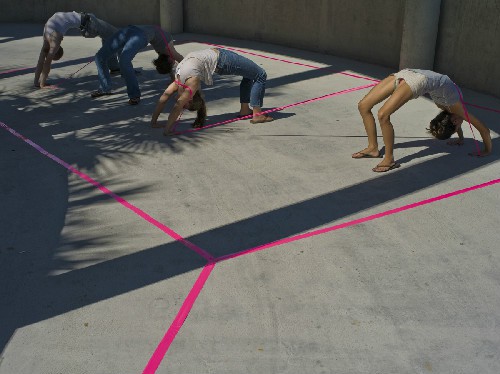Dome Drift
Installation, Miami, FL.Installation of the collaborative exhibition "Dome Drift" by Wes Kline and Cristina Molina at the Sixth Street Container in Miami, FL. Installation included two banners fixed on the side of the gallery space, and a video and 10 minute audio installation as well as a glowing floor drawing.
Our production of the project Dome Drift derives from a shared interest in ideal spaces, for which the dome becomes a stand in. Its attachment to both communal living and the construction of community make it an ideal container for questions of intimacy, isolation, and potentiality. We approached the form of the dome as an object of double articulation--its failure to be integrated into building practice in any widespread way represents an unfulfilled ideological promise, and yet it remains connected to a democratic DIY culture that, in its heterogeneity, continues to represent a political possibility for activity and praxis.
We used the boundaries of the exhibition space, including its scale, shape, and location as the limiters for the work. We thought of the 6th street container as the site of the construction of a dome, and then decided that we wanted to emphasize the dome as a site of potential, rather than actuality. With this in mind, we decided to "produce" the dome through a combination of audio, text, drawing, and performative video. Consequently, the outsides of the space are covered in two vinyl banners - a text banner and a photographic banner, and the inside is a surround sound audio installation with video, and a floor drawing of a flattened and abstracted dome structure. The audio installation involves a conversation between four 'specialists' - an architect, a yoga instructor, an opera singer, and a mathematician - in which each of these specialists describe the process of building a dome in their particular discipline. These strategies worked to produce the 'dome' as an unrealized transhistorical site, but one that viewers could imagine in a heterogenous and subjective way, rather than as a specific historical object.
Since the physical boundaries of the site were important to us, we wanted to make sure the shooting of the video was in a space large enough to house the dimensions of the 6th street container to scale. Visual clues of this 'boundary' resonate throughout the pieces, the magenta line depicts the actual dimensions of the 6th street container transposed upon both the urban structure of the UF football stadium and the rural setting of an empty plot of land in Gainesville. We asked four people who were capable of performing a physical manifestation of a dome shape (a backbend) to participate, placing emphasis on the building and collapsing of this structure within the set boundaries. Finally, the zine produced for and distributed at the opening serves as both a manifestation of the DIY culture cited in our work and as an abstracted catalog of historical visual references.
